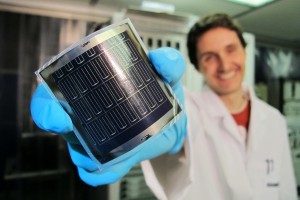
High-efficiency flexible CIGS solar cells developed at Empa. Credit: Empa.
(From Materials Views) Scientists at Empa, the Swiss Federal Laboratories for Materials Science and Technology, have developed thin film solar cells on flexible foils with a new record efficiency of 20.4 percent for converting sunlight into electricity. The cells are based on CIGS semiconducting material (copper indium gallium (di)selenide) known for its potential to provide cost-effective solar electricity. The Swiss technology is currently awaiting scale-up for industrial applications.
A team at Empa’s Laboratory for Thin Film and Photovoltaics, led by Ayodhya N. Tiwari, achieved the record energy conversion efficiency for CIGS solar cells on flexible polymer substrates, a massive improvement over the previous record of 18.7 percent achieved by the same team in May 2011. Tiwari’s team has been investigating and developing various thin-film solar cell technologies for some time. Over the years the laboratory has boosted the photovoltaic conversion efficiency of flexible CIGS solar cells time and again, from 12.8 percent in 1999—the group’s first world record—to 14.1 percent in 2005, 17.6 percent in 2010 and 18.7 percent in 2011.
Thanks to innovative ideas and excellent teamwork in the lab, especially by PhD students Adrian Chirila and Fabian Pianezzi, the team succeeded in modifying the properties of the CIGS layer grown at low temperatures.
The Fraunhofer Institute for Solar Energy Systems (ISE) in Freiburg, Germany, independently certified the cell efficiency.
Empa’s new record efficiency also exceeds the record value of 20.3 percent for CIGS solar cells on glass substrates. Perhaps more importantly, the researchers say the new record equals the highest efficiencies for polycrystalline silicon wafer-based solar cells. “We have now—finally—managed to close the ‘efficiency gap’ to solar cells based on polycrystalline silicon wafers or CIGS thin film cells on glass”, says Tiwari.
One of the main attractions to thin-film CIGS technology is that it can be produced using continuous roll-to-roll manufacturing processes that offer further cost reductions compared to standard silicon technologies. “Now it is time for the next step, the scale-up of the technology to cover large areas in a cost-efficient roll-to-roll manufacturing process with an industrial partner,” says Gian-Luca Bona, the director of Empa. Along these lines, the lab is collaborating with Flisom, a start-up company involved in industrialization of flexible CIGS solar cells.
